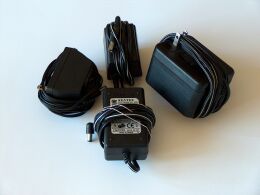9 Volt Battery Chargers
Wall Warts

The Wall Wart Collection
A power supply must provide sufficient voltage and sufficient current to a circuit to maintain the operating conditions of the circuit.
To charge a 9 Volt battery, a wall wart must put out at least 11 mA and a bit more than 9 volts. It must be DC.
The easiest thing to do is to check my wallwart collection for one with equal or greater specs.
Everyone has a wallwart collection, right?

The Winning Wall Wart
Do not connect the wall wart directly to the battery.
The wall wart is rated at 1 Amp or 1000 milliamps. That is the maximum amount of current you should draw from it on a continuous basis.
But, if there is no current limiting circuitry in the wall wart, it will provide much, much more current for a short period of time, and burn itself out, start the wires on fire, or cause the battery to explode.
This is not a flaw. Wall warts are designed this way to provide a short surge of current capable of charging up power supply capacitors or to provide starting current for electric motors.
However, some circuitry is needed to to limit the current to what is needed to charge a battery.
Ver 1.0 uses a resistor to limit current.
Ver 2.0 uses a constant current source to limit current.
Ver 3.0 improves on Ver 2.0. (Recommended)
Ver 4.0 uses an op amp and rheostat to provide 0 - 16mA of constant current.
Ver 5.0 adds a transistor to Ver 4.0 to increase the current range to 0 - 160mA

|

|
Charge Rate
Wall Warts
Simple 1 Resistor Battery Charger
Constant Current Battery Charger from 2 LED's and a NPN Transistor
9V Battery Charger from 2 NPN Transistors
Adjustable Charge Rate Battery Charger from Op Amp
0 - 160 mA Adjustable Charge Rate Battery Charger
Test Results
741C Cheat Sheet
sparksandflames.com
Sparks and Flames
Line2:
Fax:
Copyright © 2020

